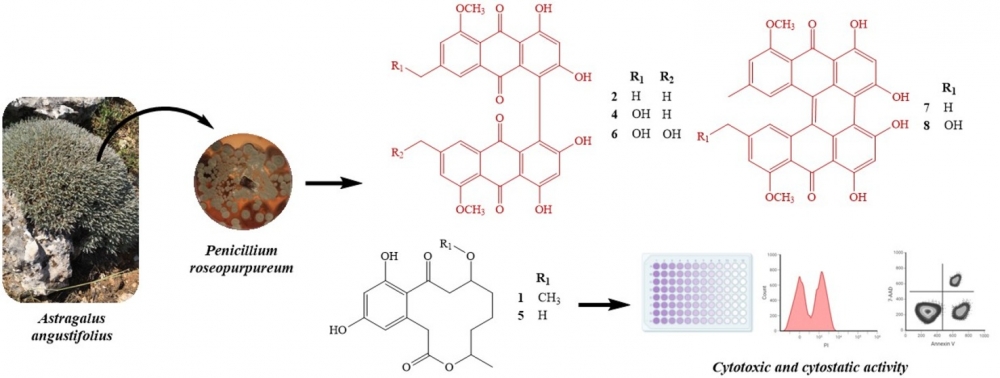JOURNAL 2896
Records of Natural Products
Year: 2024 Issue: 1 January-February
p.95 - 106
Viewed 1215 times.
GRAPHICAL ABSTRACT

ABSTRACT
Endophytic fungi colonize the internal and distinct tissues of the host plants. In recent years, there has been growing interest in endophytic fungi as valuable sources for drug discovery based on their rich metabolic profiles consisting of novel and bioactive compounds. Accordingly, our preliminary study demonstrated that an endophyte, namely Penicillium roseopurpureum isolated from Astragalus angustifolius, had high chemical diversity with an antiproliferative effect. Herein, fermentation of P. roseopurpureum resulted in the production of five new anthraquinone-type compounds (2, 4, 6, 7, 8) together with several known compounds [11-methoxycurvularin (1: epimeric mixture of 1a and 1b), carviolin (3), 11-hydroxycurvularin (5: diastereoisomeric mixture of 5a and 5b) and 1-O-methylemodin (9)]. The structures of the new compounds were established by NMR spectroscopic and HRMS analysis. Cytotoxicity studies demonstrated that none of the compounds except for 1 and 5 had antiproliferative activity against prostate cancer cell lines. Interestingly, 1 was found as cytotoxic, whereas 5 exhibited cytostatic properties. Also, 7-AAD/Annexin V staining supported these results by showing that 1 caused cellular death, while 5 did not show any increase in dead cell content in comparison to the control. Lastly, cell cycle analysis showed that compounds had distinctive cell cycle arrest patterns.
KEYWORDS
- Endophytic Fungi
- natural Products
- anthraquinones
- macrocyclic Lactones
- cytotoxicity
- cell cycle arrest